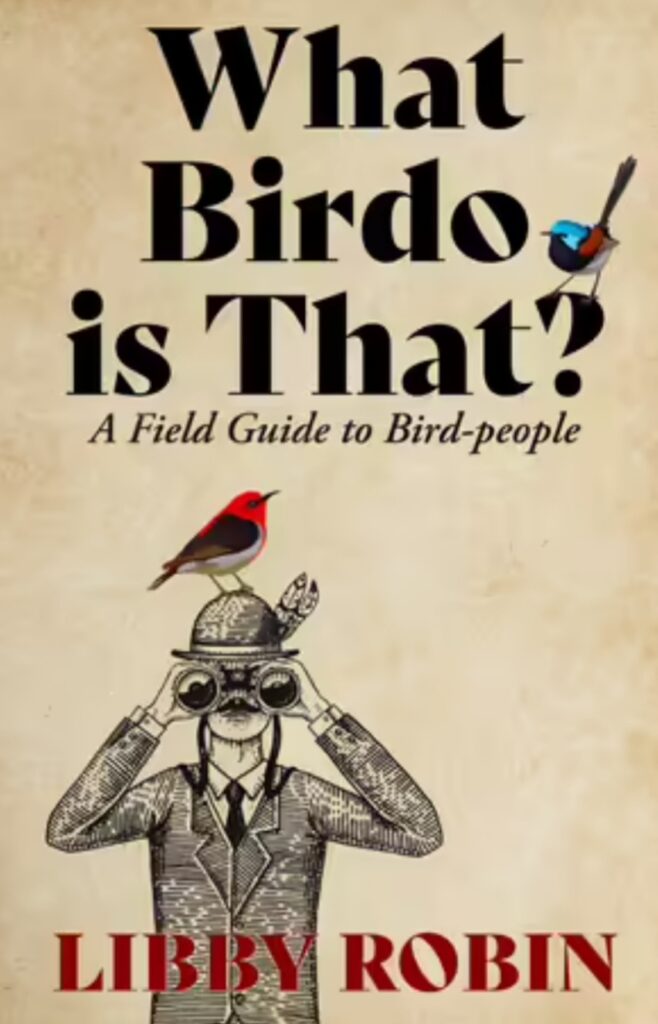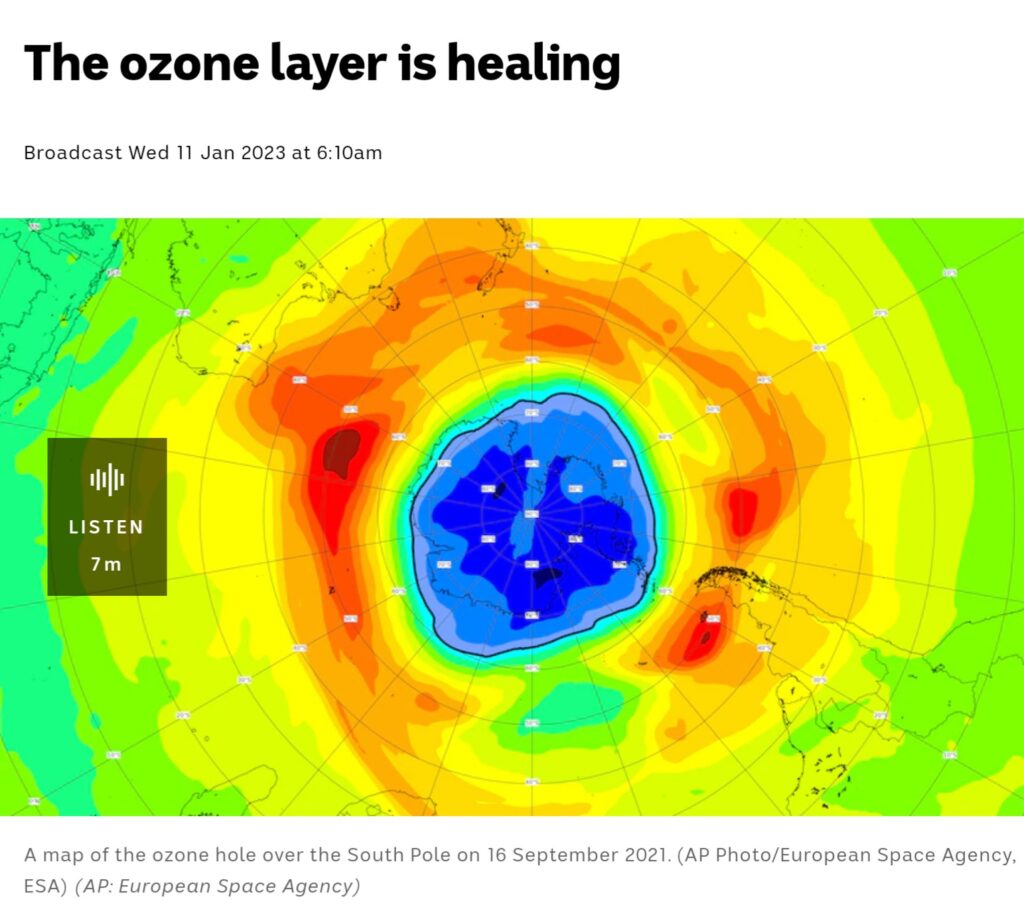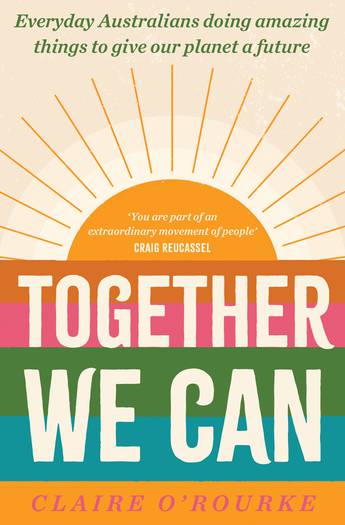
Together we can – Everyday Australian doing amazing things to give our planet a future
A review by Alison Rogers – February 2024
Author: Claire O’Rourke
Published: 2022
Publisher: Allen and Unwin
ISBN: 9781761066818
If you are looking for a book that will reinvigorate your passion for climate action, this inspiring book is your answer. I found it to be highly motivating. I have a stronger understanding of the climate action movement and how the small things I do are contributing to change. I’ve always tried to keep that bigger picture in mind when working on the local level, but the difference is that this book had helped me to join the dots. Author Claire O’Rourke helped me to clearly see the pathway from individual and local community actions through to global change.
The book is an engaging easy read that was informative and thought-provoking. Case studies, personal stories and success stories from around the world are peppered with the latest, most effective strategies. It includes recent examples of how individuals, groups, and organisations in different locations are forging collaborations to influence decision-makers.
At the back of the book a section titled ‘Climate action starts here – Everything you need to get moving’ provides a resource that you can return to for more ideas. I found ways that I can improve what I am doing based on evidence, and identify more ways that I can contribute.
The best thing about reading this book was the way it made you feel part of a movement – a wave of momentum that is building towards a tipping point. O’Rourke tackles all the doubts and worst-case scenarios head on, and provides realistic and alternative visions of how we can, and are, achieving positive change. The power of this book for me was making me realise that I am not alone, that there are many people on this journey and that we are heading in the right direction soon to reach the tipping point for change. Any time I need a top up of enthusiasm in future, I will be dipping back into this motivating and practical book.
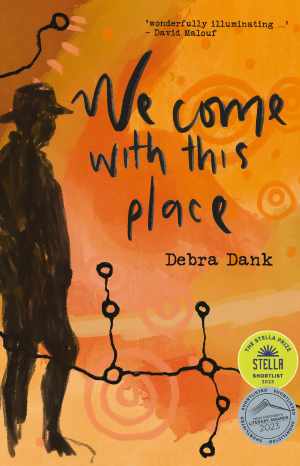
We come with this place
A review by Alison Rogers – January 2024
Author: Debra Dank
Published: 2022
Publisher: Echo Publishing
ISBN: 9781760687397
This book stayed with me for days. One of my criteria for judging a book is how long it takes my subconscious to reflect and settle. For days after I finished reading, my mind took me back to the campfires and the fishing trips and the walks through the gulf country in northern Australia that are vividly described by Aboriginal author Debra Dank. Gudanji Country was magnificently captured in this short, quick-moving and engaging autobiographical piece that I did not want to leave even after I had turned the last page.
I am a white Australian who loves being in nature – in the bush or in the sea. I have been privileged to work and travel with Aboriginal Australians on their country when I was living in the Northern Territory. I have always been open to learning about what nature and country means for First Nations Peoples. However, I feel this book explains what connection to country means for Aboriginal and Torres Strait Islander people in a better way than any other book that I have read or any of my previous experiences.
Dank generously shares her knowledge with the reader to help us understand what connection to country means to her and her family. Through her interactions with different generations we see how knowledge is shared and how nature shapes the way her family lives their lives.
But the true nugget of gold in this book is the love story. I felt privileged to read about how Dank fell in love with her non-Indigenous husband Rick and navigated their cross-cultural and lifelong learning partnership. This relationship in the story was the keyhole through which all non-Indigenous readers can appreciate what it means when an Aboriginal person says, “We come with this place.”
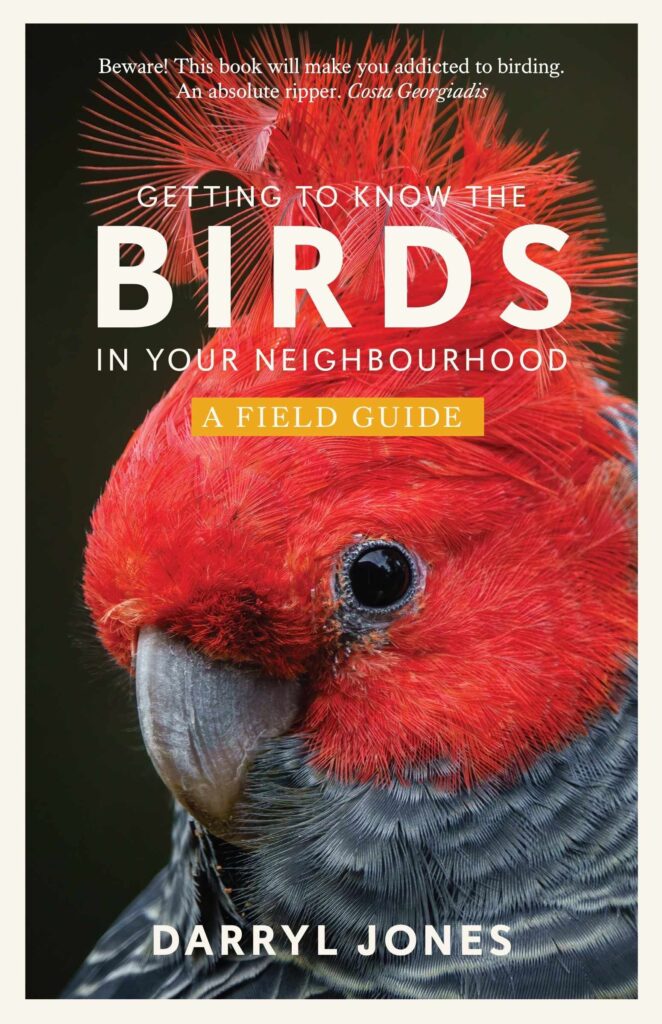
Getting to Know The Birds in Your Neighbourhood
A review by Lyndal Morrow – January 2024
Author: Darryl Jones
Published: November 2023
Publisher: UNSW Press Ltd
ISBN: 9781742238050
Australia is a bird lovers paradise, but for those new to birdwatching, Darryl Jones suggests staying local and getting to know ‘the neighbours’ instead. The birds that are hidden in plain sight – backyards, bush reserves and parks. Engaging and fun, this field guide is easy to read, sparks curiosity and inspires outdoor participation – rather than just ‘googling it’. Jones wants the newcomer to experience the joy of birding.
This field guide to Australian birds is aimed at beginners . It’s concise, simple and visually stunning. It’s of practical size to carry outside or to slip inside a daypack on a morning or afternoon walk. It’s designed to enhance the ease and joy of birdwatching, rather than be overwhelmed or confused by too much information.
To keep it simple, Jones concentrates on bird families, whilst information on each bird in the main section is kept short, relevant and interesting. It’s accompanied by coloured photographs of each bird for identification. There are some spectacular photographs throughout the book that show more of the incredible beauty, personality and interesting behaviours of some of our feathered friends than words can speak.
Jones encourages and inspires readers to find a greater connection to ourselves and nature through birdwatching. Birdwatching hones the senses – watching, listening, pausing. It can bring us into the present moment, paying attention to the here and now. Mindfulness. This guide is preparing us to take flight into another world.
Unsurprisingly, studies have shown that birdwatching can improve wellbeing and even help people recover from depression. It’s a joyful activity that creates connection and provides relief from loneliness, and stress. Many people, including me, found a new or renewed love of birdwatching through COVID.
Darryl Jones is a Professor of Ecology from Griffith University who’s had a longstanding interest in how wildlife thrive in urban environments, so there’s a short section on habitat, ecology and human interaction upon birds. To further engage us, he gently reminds us of the responsibility we have to our shared space and how we can better cohabitate in the face of a biodiversity crisis. There are tips and suggestions to help attract, support and better protect our local birdlife.
Last, but not least, Jones respectfully acknowledges First Nations people as the first birdwatchers and emphasises the sophisticated relationship they have with the natural world. They demonstrate a rich understanding of Australia’s biodiversity that developed over millenia. Following consultation with Elders, a catalogue of indigenous bird names was developed and some stories are generously shared that shed light upon the habits and behaviours of various species.
This is a guide for beginners that will give wings to the mind and joy to the heart. It’s especially recommended to anyone who’s looking to start the new year with a new passion, or purpose. It’s also made the long list for the Indie Book Awards 2024 – illustrated non fiction.
Interview with Darryl Jones – ABC Radio National 15 November 2023
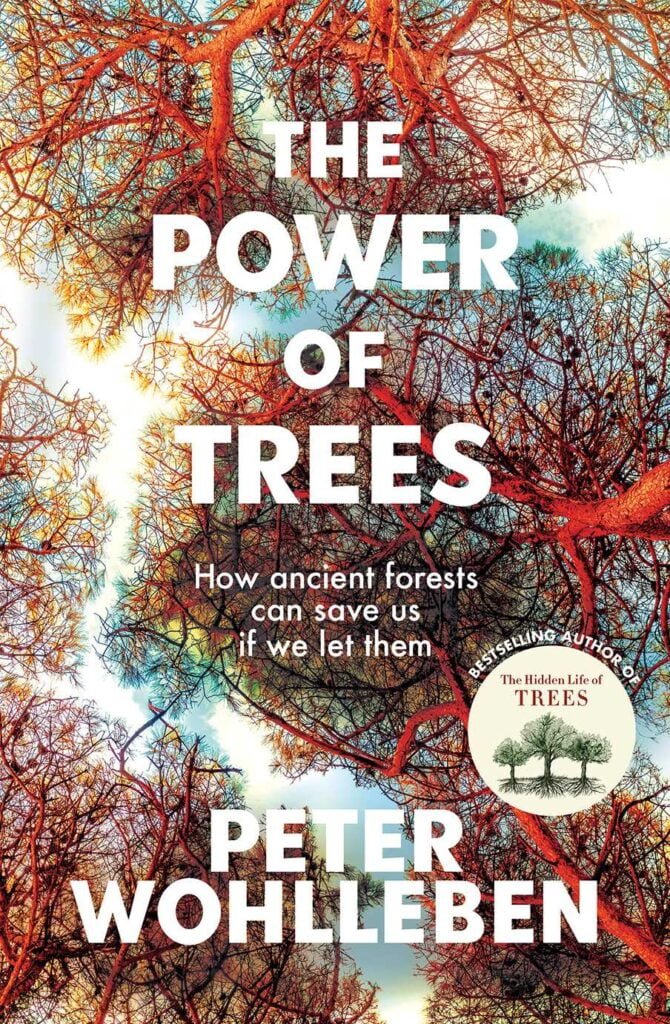
The power of trees – How ancient forests can save us if we let them
A review by Alison Rogers – December 2023
Author: Peter Wohlleben
Published: 2023
Publisher: BlackInc.
ISBN: 9781760643621
The Power of Trees is Peter Wohlleben’s latest book and follows bestselling titles such as The Hidden Life of Trees, The Heartbeat of Trees and the children’s book Peter and the Tree Children. The Hidden Life of Trees was also made into a television series and some of the books have been reproduced with beautiful illustrations.
Wohlleben’s love for trees is evident throughout every chapter. He is passionate about helping the reader to understand how trees communicate, learn and adapt. The examples he provides from scientists are astonishing. I particularly love the case studies of plants working cooperatively to support their local ‘community’ of plants.
A certain level of scientific knowledge about plants and trees may make the information in this book more accessible. The level of detail provided would be of most benefit to readers who have some expertise in regeneration and land management. However, I was still able to absorb some of the key messages, such as developing my awareness of seeing individual trees as intrinsic ecosystems.
This book has a strong European focus, specifically on the forests in Germany. Wohlleben spent more than twenty years working for the forestry commission before leaving to put his ideas of ecology into practice. He now runs an environmentally-friendly woodland in Germany, where he is working for the return of primeval forests.
His argument, to leave forests alone and they will heal themselves, may have limited application in an Australian context. Recognising that we have a unique environment and a different historical context, may mean that Wohllenben’s theory may have less relevance when developing our bushland management plans. However, in conclusion, if this book contributes to increasing our collective appreciation of trees, then I believe it is successful.
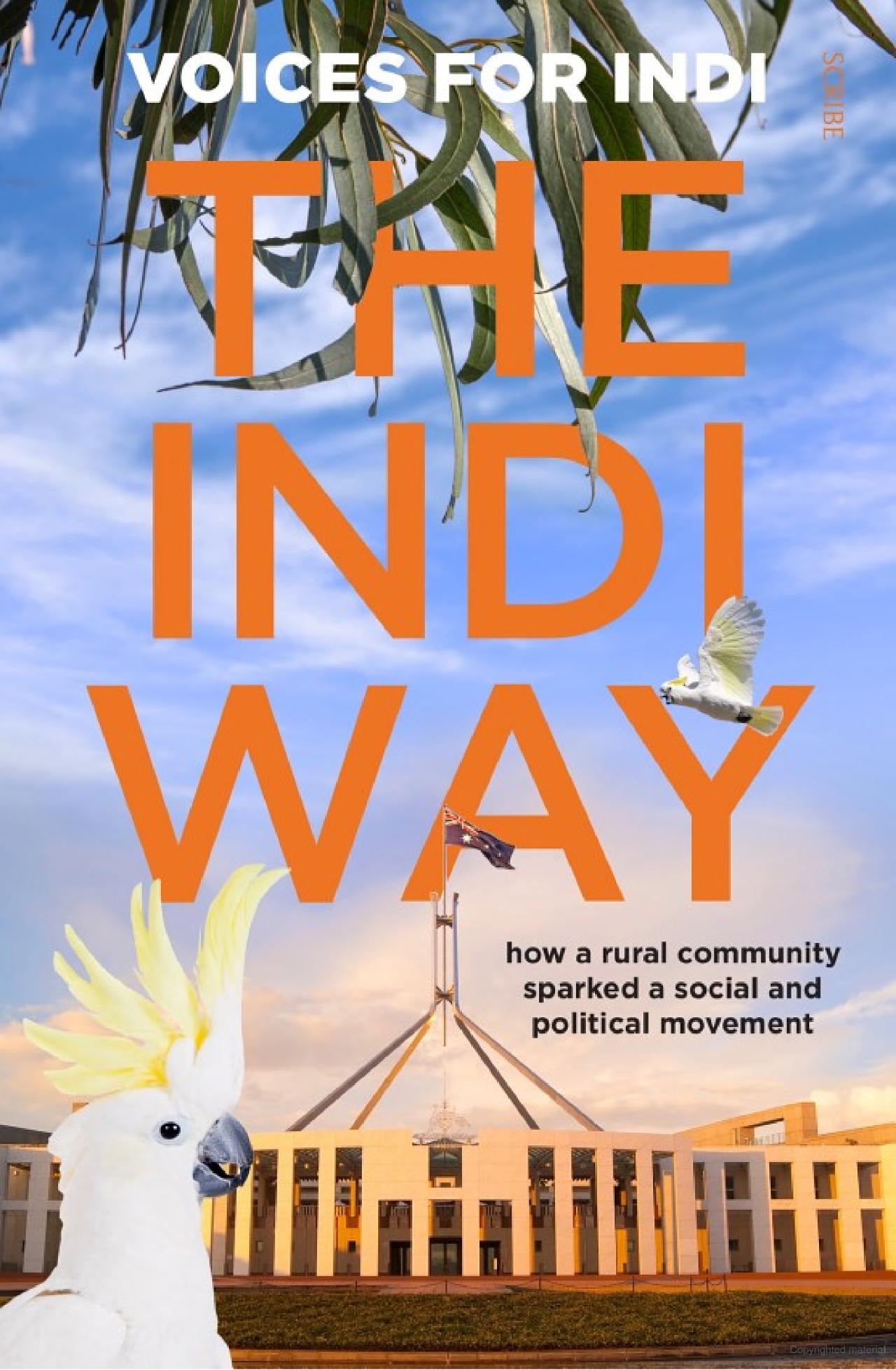
The Indi Way – how a rural community sparked a social and political movement
A review by David Dungavell – November 2023
Author: Voices for Indi
Published: 2 May 2023
ISBN: 9781761380341
Indi is a Federal electorate in North Eastern Victoria taking in several country towns like Bright and Beechworth, Mt Hotham, as well as Kinglake and Marysville in the south.
The story begins in 2012 with a small group of individuals who formed a group called “Voices for Indi”. This group were interested in bringing about better political representation for their community. The book then follows the group as they select an independent candidate for the 2013 Federal election and then contest the seat. This was a campaign about people, by the people. It could be described as a “David and Goliath” struggle of an independent against a large political party.
The book is written from the perspective of the key people involved in the process, allowing the reader to receive multiple perspectives. There are many quotes and thoughts from others involved, including people living in the electorate and volunteers involved on the team.
There is also some detail on the simple, but clever marketing techniques used by the campaign team. The marketing strategy involved mobilising supporters to talk with the constituents of the electorate, because door knocking is much cheaper than direct mail and TV advertisements.
On first glance you might think it’s a political story. It’s about how a community found a voice and brought about meaningful change for their community. Non fiction political stories are normally based on the “cut and thrust” of Canberra politics and can be a little confronting or maybe depressing. But this book explains the process a local community undertook to bring about a new relationship between the community and their elected member. And so it probably doesn’t matter what your political beliefs might be, there is something in this book if you are interested in uplifting story of community action. I really enjoyed the book because it provides an alternative view of what democracy could look like.
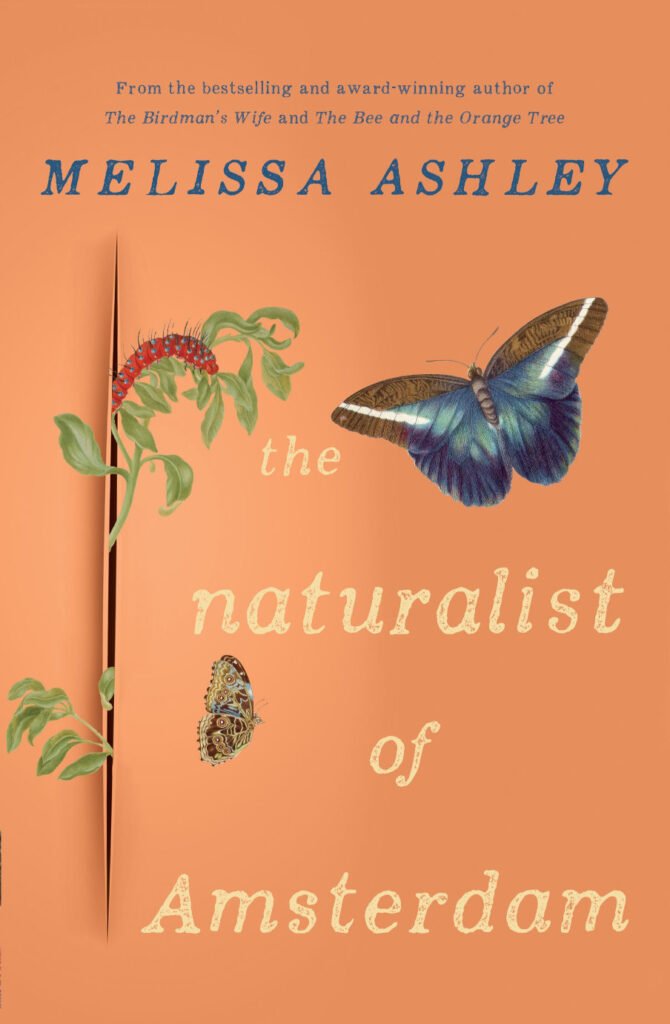
The naturalist of Amsterdam
A review by Alison Rogers – October 2023
Author: Melissa Ashley
Published: 2023
Publisher: Affirm Press
ISBN: 9781922863980
My favourite genre is historical fiction. The Naturalist of Amsterdam by Melissa Ashley did not disappoint. I was transported back to the turn of the 18th Century and felt privileged to experience life in Holland and South America’s colonial Suriname through the character of Dorothea Graff.
Dorothea’s mother was an esteemed female artist specialising in the natural world. Sacrifices had to be made so that mother and daughter could work together on creating their masterpiece illustrating the metamorphosis of insects. The book is set at a time when scientists and, in this case artists, were unravelling the wonders of the lifecycle through the newly invented microscopes. The author’s description of the artistry brought the images alive – the words stimulated my brain’s visual receptors.
The complex interpersonal dynamics between mother and daughter, father and daughter, husband and wife, and the siblings, are all evident in this novel. I was reduced to tears on at least three occasions as I was so invested in their relationships. But a scene from the book that will stay with me for a long time was when Dorothea and her mother were presented with a tasting plate of banana, sliced pineapple, papaya and guava. These had been grown in a hot glasshouse in Holland from the South American cuttings. The description of them eating these delicacies was so intense that I felt like I was tasting the fruit myself. I had an emotional reaction that mirrored their joyful experience.
For people who love books that offer a long deep dive into another time and place, this book will deliver. The depictions of the natural world through the eyes of artists fosters a deep appreciation of things that we may not otherwise even notice. The author has an amazing talent for not only making readers emotionally invested in the characters but making us feel their sensory experiences of vision, smell and taste.
What Birdo is That? A Field Guide to Bird-people
A review by Alison Rogers – September 2023
Author: Libby Robin
Published: 2023
Publisher: Melbourne University Press
Paperback ISBN: 9780522879346
I love lists. My love of ticking birds off a list started when I checked into the Mornington Wilderness Sanctuary in the Kimberly region of Western Australia. The reception pack included a list of birds. Although I did not see the Gouldian finch that had been rumoured to be recently sighted, the satisfaction of placing the tick on the page was the start of my amateur interest.
A few years later, the infectious passion of a nature guide called Wendy, who works on the island of Langkawi in Malaysia, reinvigorated my affection for birds. I felt a sense of awe when I heard the call of the Great Hornbill and then when I saw it at the top of the rainforest canopy. But what I remember most about that day was Wendy – her close study, not only of birds, but the types of humans that are interested in birds was intriguing! While I fitted into the category of casual tourist, she told me about the characteristics of birdos from different countries and birdos with differing aspirations … those that love the lists and others that need the photo!
Libby Robin’s book What Birdo is That? A Field Guide to Bird-people explores what people who notice birds have in common. In contrast with people who do not notice birds, Robin includes amateur birdos, professional zoologists, and people who build their gardens to support birdlife or ‘bird scapers’. Impeccably researched, Robin explains from an Australian perspective how the field developed, including the history of where terms such as ‘twitcher’ come from and how the organisations that support bird watching have evolved over time. It is no wonder that Robin is an accomplished natural history and conservation writer who has won prizes for her work exploring environmental ideas. Robin writes:
Birdwatching is a cover for conservation, for land management, for understanding ecological connections, for relaxation and happiness, for garden philosophies. It is also a basis for international diplomacy, for understanding global interdependency. Birds lift our eyes to the skies. They make visible the changing flows of the great atmospheric ocean that supports all life on our small blue planet.
In parts of the book I found the level of detail to be quite overwhelming. For example, I was not particularly interested in the backstory of when the national bird programs amalgamated into the CSIRO and then to the National Parks and Wildlife Service. But as a reader I was very willing to let these intricate details wash over me because within a page or two there was always another beautifully written personal story that I could connect with emotionally. Robin has also carefully balanced Indigenous perspectives from Australians and globally with Western science to illustrate how different world views can be brought together to provide a more holistic understanding.
This book is ideally suited to engaged birdos who want to understand how the practice of birdwatching has developed historically. Readers will be inspired by the variety of different professions and people who contribute. It would make an ideal gift, especially with such a magnificent cover and catchy title, for any birdo who is interested in reflecting on the changes in the field and where it is heading. However, I think that anyone with even a passing interest in birds or the environment will find enjoyment in these pages.
Thanks to Robin, I now understand that because of my heightened awareness, instigated by lists of birds and interactions with passionate birdos, and my participation in the annual Aussie Bird Count, I belong to a broad conservation community:
Noticing is important. The story of birdos is not just about the ‘ones with the binoculars around the neck’. The bigger, more inclusive birdo community supports all sorts of nature. By nurturing habitats that attract birds and make them sing, birdos conserve lively habitats for humans as well.
(Extra note: For a more humorous fictional story about birdwatchers check out The Birdwatcher by actor, comedian and bird nerd William McInnes.)
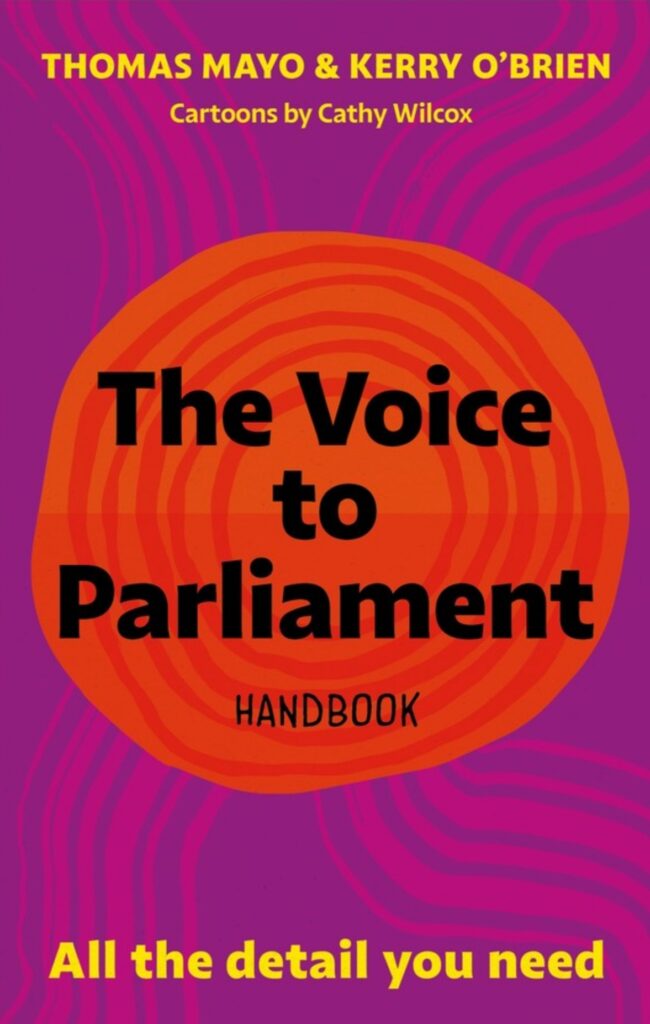
The Voice To Parliament Handbook
A review by Ewa Meyer, July 2023
Authors: Thomas Mayo and Kerry O’Brien
Published: 2023
Publisher: Griffin Press
RRP: $16.99
Paperback ISBN: 978-1-741-178869
Just to be clear, I didn’t buy this book because I needed convincing that Aboriginal and Torres Strait Islander peoples should be included in the Constitution – or that I personally needed more detail on how The Voice to Parliament will work. I was keen to read it because there are others in our local communities who are oblivious to the significance, and inherent simplicity, of what the Uluru Statement of the Heart has achieved to date, and what this Federal Government is proposing in this year’s referendum. This book provides guidance on how to hold respectful discussions with those who don’t agree with this process, or recommends it to those who have switched off because they are put off by the partisan politics that has taken the focus away from what this is really about.
We must not switch off – we have to find a way through the foggy and murky Canberra atmosphere, and the misinformation on social and other biased media. The messaging from the government has not been good and has been overshadowed by short media grabs from the opposition. Such as ‘if you don’t know, vote no.’ How about – ‘if you don’t know, get informed?’ But please not by politicians – listen to the legitimate NO camp – the many, mostly indigenous people who don’t consider The Voice as an adequate vehicle for providing them with serious decision-making, let alone any governing capability they should be entitled to as the original peoples of this land. Their concerns include that if this referendum passes, the Voice advisory body’s advice is not obliged to be accepted.
This Handbook summarises the process to date and the failures of previous programs or entities like ATSIC, all of them have ended up being watered down or abolished as governments have changed. It also addresses many ‘frequently asked questions’, some authentic and some not, and encourages all Australians to become as well informed as they possibly can, before making their decision on the future of our fellow Australians. The requirement for a Voice would be enshrined in the constitution, but the details of how it operates and functions would be left to the Parliament of the day to decide. Just like other constitutional matters, taxation system etc, which are not detailed in the constitution so they remain flexible and adapt to change.
I recommend this book to those of you intending to vote YES. The more we understand why we’re voting YES, the better equipped we will be to help others understand and to answer concerns or falsehoods that might come up in conversation or on social media with work colleagues, acquaintances, neighbours, friends or family.
Of course, if you’re intending to vote NO – you should read this book first, just to hear another view than whatever has influenced you thus far. And if you are as yet UNDECIDED, then this is primarily for YOU – it’s one of the quickest and simplest ways you can grasp the main issues without being bogged down in the political games and misinformation.
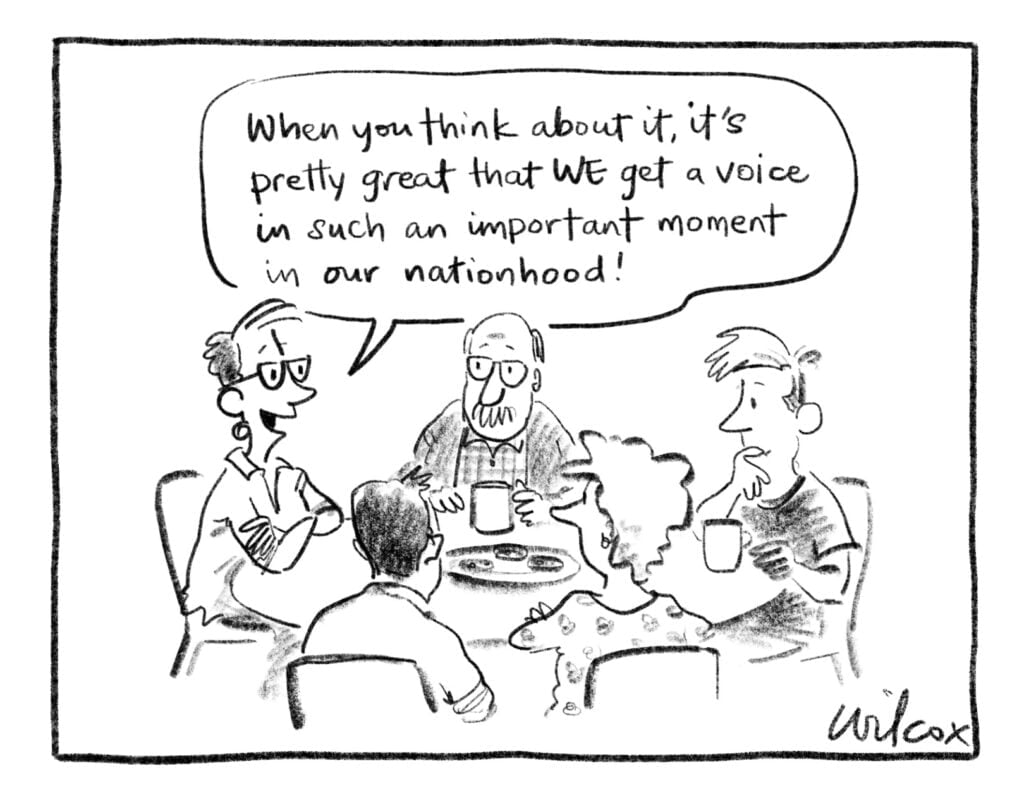
As a middle-aged white woman, I am privileged and humbled to be asked to vote on something that will not affect me personally. I’ll wake up the morning after the referendum and go about my business as usual. For thousands of other Australians, their opportunity to have a mechanism through which they can express their opinions on matters that affect the lives of Indigenous communities will be lost for what could be another generation.
We can try to empower you, but nobody can tell you how to vote in the referendum – so please make it an informed decision, and encourage others to open their hearts and minds.
Oh and did I mention the wonderfully insightful cartoons by Cathy Wilcox which illustrate the handbook? Many thanks to Cathy for giving me permission to reproduce a few in this EcoUpdate.
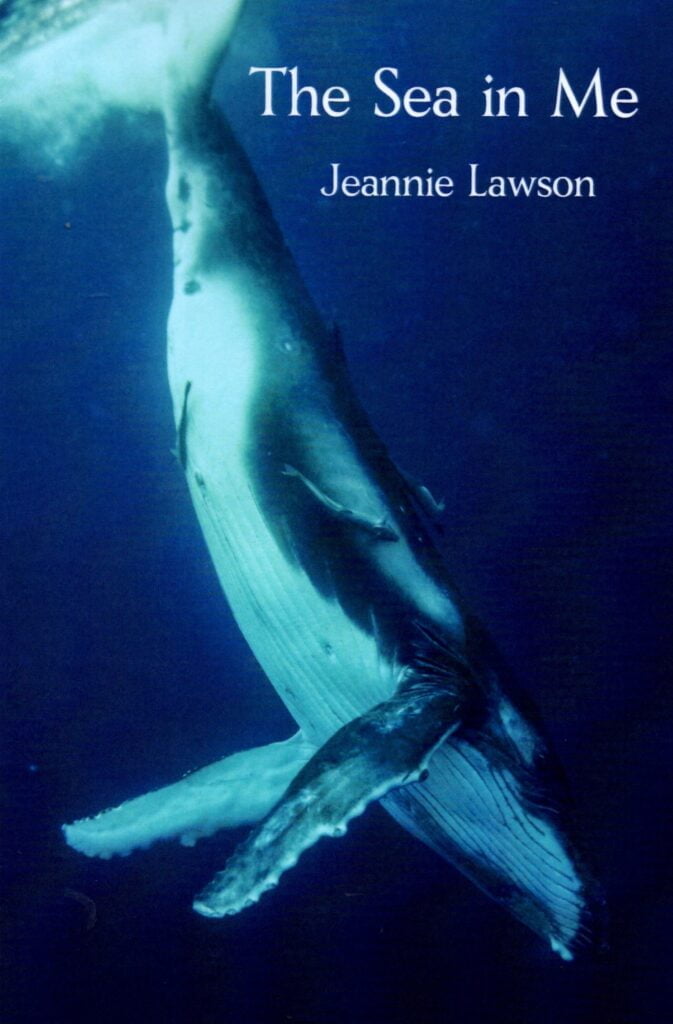
The Sea in Me
A review by Alison Rogers, June 2023
Author: Jeannie Lawson
Published: May 2023
Publisher: Ginninderra Press
RRP: $20
Paperback ISBN: 978-1-76109-515-3
I first met Jeannie Lawson in 2022 onboard an Imagine Cruise where she was guiding a whale watching experience. The whale season was nearly over, and I had low expectations of a sighting. When Jeannie pointed out a mother and calf my eyes welled with tears – an instantaneous emotional reaction. Then when mum and calf woke from their nap and performed a synchronised breach, I became a blubbering mess. Jeannie put her hand on my shoulder and softly spoke ‘don’t worry – no matter how many times I see them – it makes me feel the same way.’
Many of us have experienced awe from interacting with nature. What makes Jeannie’s emotional connection to nature so special, is that she can translate her experiences into poetry. In The Sea in Me there are many examples of how she captures the essence of her empathetic reaction, like this poem about dolphins:
Sea Spirits
Quick as a thought they slide through the ocean
Gliding and diving, delighting in motion.
Twisting and turning back over and under,
Faster than lightning and deeper than thunder.
With a flick of the tail they soar through the sea,
Laughing and loving and living and free.
Riding the bow waves before racing on,
A few precious moments and then – they are gone.
Slipstream of memory caught in a glance
Somersault feelings of joining their dance.
Jeannie moved to Port Stephens in 2015 having been working in the area for the past 20 years. She has had many different roles, such as delivering programs and environmental talks, as well as conducting tours for many different organisations. Jeannie has been associated with Imagine Cruises for 22 years and has worked as crew and as a whale watch guide for over 8 years.
Jeannie’s volunteering experience is also extensive. In 1999 she founded the organisation Ocean and Coastal Care Initiatives (OCCI) which now has branches on the Central Coast, Lake Macquarie, Newcastle and Port Stephens. OCCI focuses on life in the intertidal zones such as rock pools and seagrass, delivering educational talks, tours and awareness-raising programs. She co-founded the Whale Dreamers Festival which has been held at Norah Head on the Central Coast for 16 years. Jeannie was also a founding member of the Central Coast Branch of the Organisation for Rescue and Research of Cetaceans in Australia (ORRCA) and was a co-writer of the blueprint for Clean-up Australia Day.
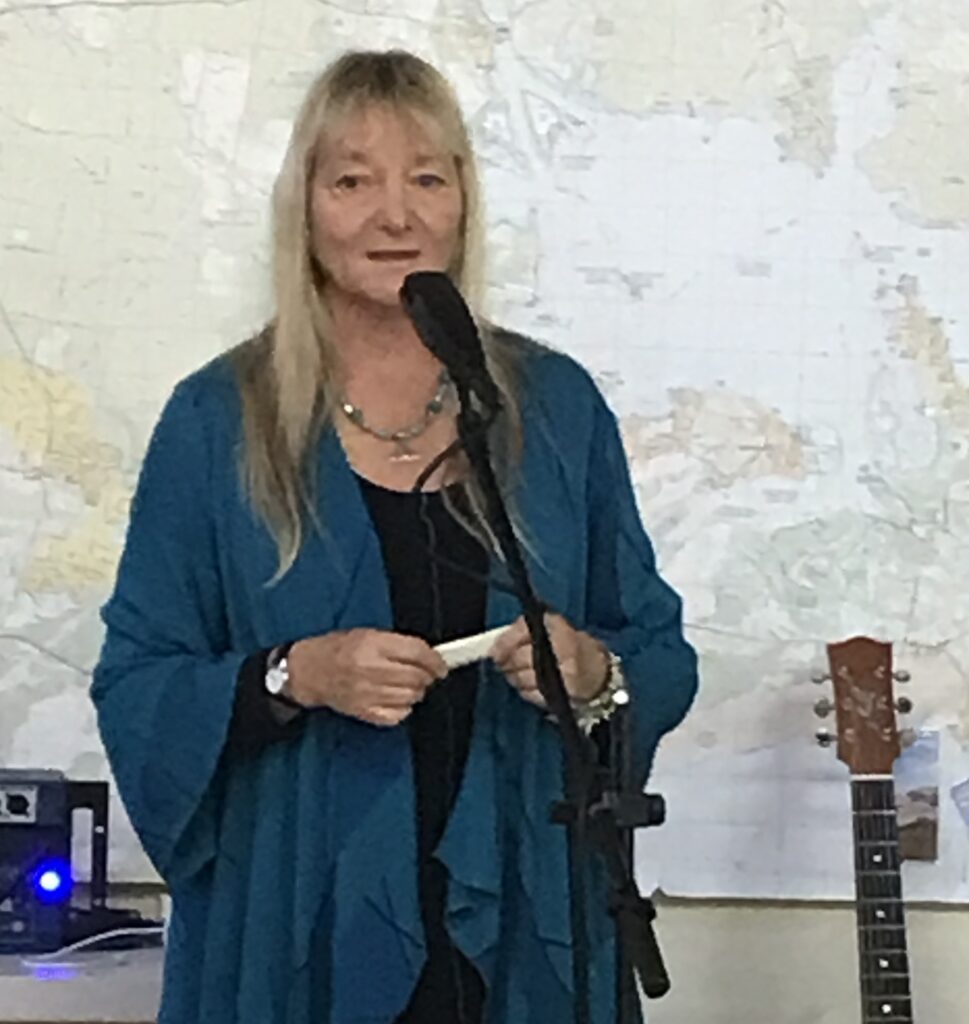
Although Jeannie’s volunteer roles are focused on the ocean, it was Charly Wellard, the MC at Jeannie’s book launch, who provided this clarification: ‘Everyone knows Jeannie has extensive knowledge about the marine world but her expertise extends far beyond – she is knowledgeable about so many aspects of the natural world.’
The book launch was held in May 2023 at Tilligerry Habitat where Jeannie was surrounded by proud family, friends and colleagues all keen to congratulate her on publishing the book and celebrating her achievement. When I asked her about her work and how it makes her feel on a personal level she said ‘volunteering makes me feel like I am making a difference in some way … everything I do is associated with the environment – that is where I get the inspiration for a lot of my poetry. Nature is my spiritual home.’
Jeannie has been writing poetry for decades which is evident in the quality of pieces contained in this book. I highly recommend Jeannie’s poetry to anyone who would like to explore how the feelings of awe and wonder associated with nature can be put into words.
Copies can be purchased for $20 on-line at www.ginninderrapress.com.au or hard copies from the Visitor Information Centre at Nelson Bay. You can also get in touch with Jeannie directly by email.
Book cover photo credit: Lisa Skelton Photography, taken on Jeannie’s first whale swim in Tonga, 2016.
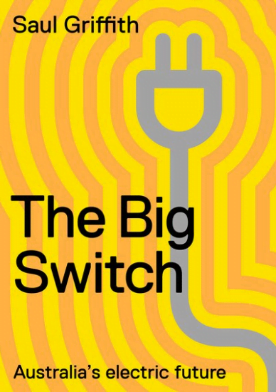
The Big Switch: Australia’s Electric Future
A review by Rob McCann, February 2023
Author: Saul Griffith
Published: 14 Feb 2022
RRP: $23.75
Paperback ISBN: 9781760643874
eISBN: 9781743822371
Saul Griffith is a straight-talking scientist, inventor CEO and founder of several successful companies. He is exactly the kind of person needed right now in the ever-important discussion on energy. After working on the biggest piece of climate legislation in US history, he has moved back to his native Australia and written a book on energy. The Big Switch proposes a smart, viable and achievable pathway out of the mess we are in here in Australia. And we are in one hell of a mess.
The first thing to say is that this topic (energy) is so incredibly important, yet it remains so poorly understood and communicated, so the mere fact that he wrote it – and did so in accessible language – is laudable. The book is loaded with useful facts, statistics, charts and diagrams, and will arm the reader with the tools needed to engage in a robust discussion on energy with your friends and colleagues. It will polish your BS detector, and have you yelling at the TV when commentators or politicians spout nonsense about our energy market.
Saul’s book proposes a very strong case for cautious optimism. His overarching idea is quite simply to electrify everything. That is to say, the path to lowest carbon and lowest cost is through cutting out the middle man (gas, coal, oil, hydrogen) as it were, and send and use energy directly in the worlds machines to where is needed without the use of combustion. This is cheaper, more efficient, anti-inflationary and more sustainable. This principle applies to both your household, the grid and to major industrial processes alike, and I cannot fault it.
You don’t get better, more efficient, lower cost and lower carbon energy by designing machines, systems or processes which require more moving parts and who’s fuel source requires vast amounts of processing, like LNG or hydrogen. These are not more efficient or clean. In fact, the energy, time and cost used to produce these are extraordinary when compared with pure electric derived from say wind or solar. This book is extensively researched, the writing is easy, non-technical and often conversational, but sometimes rushed I have to say. Nonetheless, this is one of the best arguments for clean energy I’ve come across. I learned a lot from this book and you will too. Go read it and let’s electrify everything!
About the Author
Saul Griffith, PhD, is an Australian engineer and inventor. He’s been a principal investigator on research projects for NASA, Advanced Research Projects Agency-Energy, the National Science Foundation and US Special Operations Command. He was awarded the MacArthur ‘Genius Grant’ in 2007.
Industry Reviews
‘About f-ing time we have an actual plan written down that can be executed and financed. In a decarbonised world, Australia is a winner. The opportunity now is ours for the taking.’ — Mike Cannon-Brookes
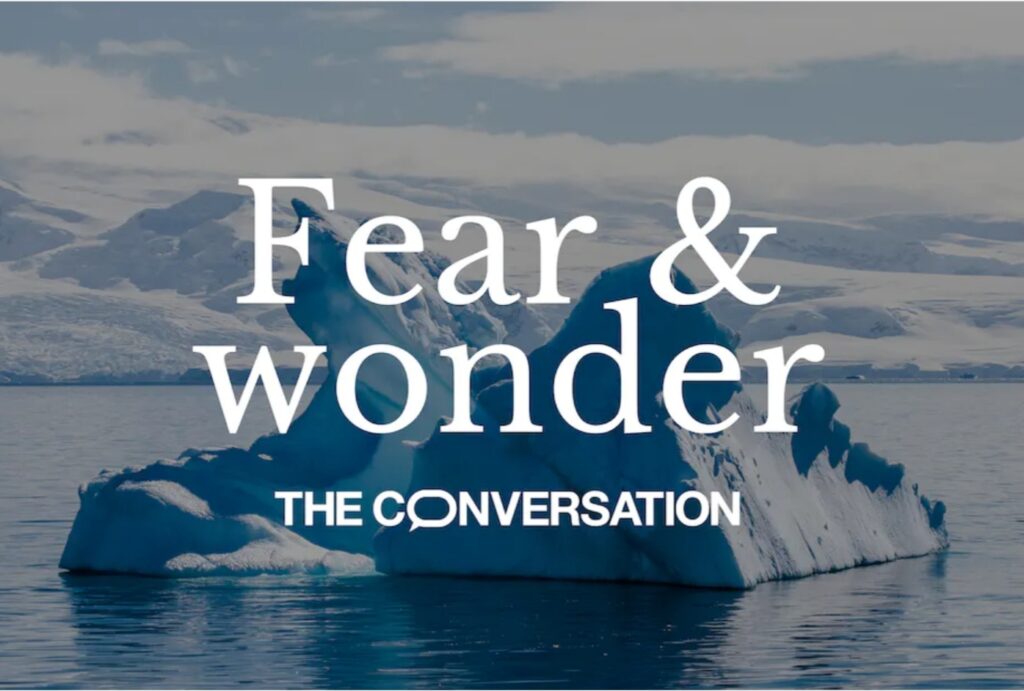
So how do scientists know the climate is changing?
And what does it feel like to carry that knowledge and do their vital work at this crucial juncture in Earth’s history?
Fear & Wonder is a new podcast from The Conversation that takes you inside the UN’s climate report via the hearts and minds of the scientists who wrote it. Hosted by climate scientist Dr Joelle Gergis and lead IPCC author and award-winning journalist Michael Green. Listen to the Fear and Wonder podcast
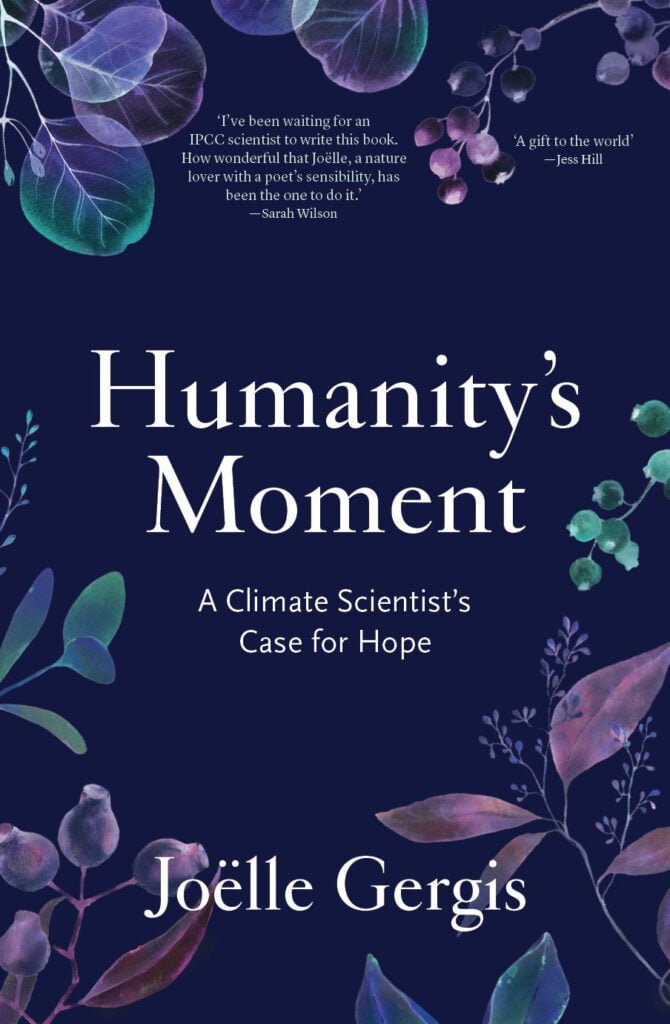
Humanity’s Moment: A Climate Scientist’s Case for Hope
A review by Tracie Hendriks, January 2023
Author: Joëlle Gergis
Published: 30 Aug 2022
RRP: $34.99
Paperback ISBN: 9781760643232
eISBN: 9781743822531
I am writing this review as a member of the public with an interest in climate change and strong sense that something must be done urgently to combat it. I do not have any qualifications in environmental science, ecology, or climatology. Dr Gerges is a well-respected climate scientist at the Australian National University in Canberra.
For most part the book provides much data about what is happening now to our climate and how that is affecting all areas of our environment and ecology. Dr Gerges outlines four specific pathways that climate change might take from keeping the temperature change to +1.5 degrees C to the worst scenario of >4 degrees C. All the projections over 1.5 degrees C are bad to horrendous to contemplate. Dr Gerges goes on to outline how these pathways will affect our land, water and living environments, our food and water security, population displacements and societal structures. The worst scenarios will result in a basically unliveable world by the end of this century.
We are currently on the second pathway and if we don’t act urgently this will worsen. Many of the changes have already begun. We are experiencing worse and more frequent events such droughts, fires, and floods, than the world has seen for thousands of years with many animals becoming extinct, or facing extinction, especially here in Australia. There is melting ice in the Arctic and Antarctic, coastal erosion, crop failures, the movement of sea life away from the equator and death of a large proportion of the Great Barrier Reef.
While the language the book uses makes it very easy to understand, and technically easy to read, the book took me a long time to read. It was emotionally challenging to the point of needing to take frequent breaks from all the bad news. I had not realised what climate change really meant and how all encompassing its effects would be. It was a good lesson.
It is not until the last chapter that Dr Gerges puts forward her case for hope. She bases her ‘hope’ in a belief that the ordinary people of the developed world, you, me and our friends and family, would do enough – somehow – to mitigate climate change. I do not share her view that as individual households we can do that.
I think this book is definitely worth reading and I encourage as many people as possible to read it so that we are adequately informed when it comes to making important decisions for the future.
From my perspective the only thing that will reduce our carbon emissions enough to prevent unrelenting devastating changes within the necessary time frame is to totally cease burning fossils fuels for energy well before 2050. We are already at a point where some of the effects of climate change are irreversible. And we need to reduce our use of fossil fuels by 50% by 2030 to contain it at this level.
Australia is lagging behind the rest of the developed world because of our addiction to the wealth made by selling coal, and to the interests of our governments in their relationships with the fossil fuel lobby. So, therefore the only way we as individuals can alter the course of climate change is to alter our governments view of climate change and the relationship with the fossil fuel industry. That means that our ability to alter climate change is in our ability to lobby politicians and to vote.
Please use your voice to government well, strongly, and frequently.
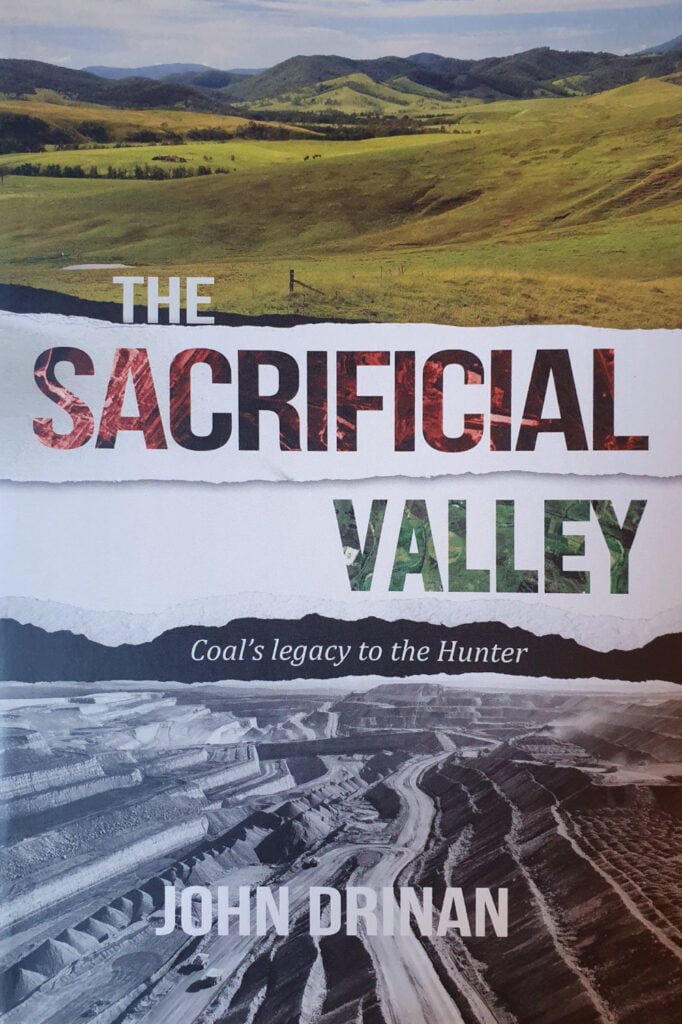
The Sacrificial Valley: Coal’s legacy to the Hunter
A review by Paul Maguire, January 2023
Author: John Drinan
Published: 2022
RRP: $25.00
Published by: Bad Apple Press
Is redemption possible?
Imagine Sydney Harbour. It’s beautiful, right?
And enormous, stretching from The Rocks all the way to Watsons Bay and out to Manly.
Now picture an Upper Hunter open-cut coalmine.
It’s a dirty, big, degraded hole in the ground.
No comparison?
In terms of aesthetics, they’re poles apart.
Now consider this.
Sydney Harbour covers 5500 hectares – that’s 55 square kilometres.
A 2016 report said there were 29 open-cut coal mines in the Upper Hunter.
Some pits were kilometres long and more than 300 metres deep.
Their total surface area, back then, was over 4554 hectares – that’s more than 45 square kilometres.
That report was about seven years ago and every day since, coal companies (largely foreign-owned) have continued ripping up the Hunter region as if there were no tomorrow.
The open-cuts are a series of gigantic, growing pockmarks with a combined size approaching that of Sydney’s iconic waterway.
The immense scale of destruction is John Drinan’s comparison point.
And, you know what?
When coal companies have finished banking their billions-upon-billions of financial profit, they can simply walk away from their mess.
That’s right.
There is no requirement to refill the shocking holes with the mountains of ‘overburden’ rock and earth they’ve dug up, and dumped nearby.
Our Sydney-centric New South Wales Government politicians and bureaucrats agree with coal company chiefs that such a clean-up would be ‘unreasonable’.
Hypocrisy is obvious.
Successive governments have accepted billions in coal royalty and political party payments for decades, while encouraging exploitative expansion.
There’s no way this permanent industrial wasteland would be okay anywhere around Sydney.
These huge eyesores will forever be left in the Hunter to fill with water that’s increasingly contaminated by toxic seepage and runoff.
This scandal is the most stunning thing I learned from John Drinan’s great book.
I’ll sum up The Sacrificial Valley in a moment.
But rather than scatter our attention on other issues Mr Drinan covers so well, I’ll stay focussed on what he has unearthed about coal’s dirty, big holes in the ground.
The demolition of our environment, I believe, is indicative of the careless approach to all coal mining impacts.
No, it’s not careless.
It’s deliberate.
The rape of our land, defiling our air and water, obliterating ecosystems and a multitude of human health issues are well-documented, long-standing, common coal impacts.
People, and their place, have been trampled by the pursuit of money.
These vast mining holes prove that Australia’s environmental protection laws have failed.
Best practice rehabilitation has also withered.
In the United States, for instance, coal companies have to backfill, compact and grade pits to restore the approximate original land contour, eliminating highwalls, spoil piles, and depressions.
On Upper Hunter mine sites, woodlands, forests and grasslands have vanished, along with the fauna they supported.
Some surface and underground water flows can never be restored.
Huge, ugly pit holes will remain for, at least, hundreds of years.
Their fill will include continually concentrated salts, chemicals and heavy metal contaminates such as mercury, selenium, cadmium and more.
The venomous mix will affect surrounding and downstream surface and underground water, stunting all ecosystems in their seeping path.
There’ll be no pristine, sandy beach fronts in the Upper Hunter.
And, this ecological ruin is knowingly bequeathed to generations who reap no benefit, have no say in the situation, yet, have to deal with it.
It’s contemptible, I say.
To sum up.
The Sacrificial Valley is clear, factual, revealing and wide-ranging.
From environmental, social, economical, human health and generational perspectives it’s an absolute shock.
The book concludes with the hope that ‘redemption is always possible’.
My hope is that it’s read, and acted upon, by decent politicians, bureaucrats, coal company decision-makers and their stock market shareholders.
More importantly, the general public should read The Sacrificial Valley and pressure wrong-doers to clean up their mess, and spur a just transition to alternative energy and a safer future for us all.
How to warm your heart in seven short minutes
By Kassia Klinger
“It’s a new year and after the last few ‘unprecedented’ ones here’s some long-awaited good news. The ozone layer is healing. Yes that’s right the global community, every nation on earth, agreed to the Montreal Protocol in 1987 and while it hasn’t been a quick fix it’s heading in the right direction.
Paul Newman is co-chair of scientific assessment and Chief Scientist for Earth Sciences at NASA’s Goddard Space Flight Center was interviewed by Summer Breakfast presenter Hamish Macdonald on Radio National on January 11.
Happy listening …”
I’m listening to ‘The ozone layer is healing’ podcast with the ABC listen app.

